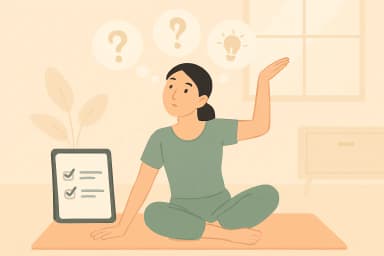
Reviewed by Arisa Tanaphon, Certified Pilates Trainer, Pilates & Mindful Movement Specialist
Why a quiz at all?
Generic workouts work for a week. Tailored plans tend to stick longer because they match your goals, schedule, and constraints — and timely, context-aware reminders help you show up. That's exactly what digital health research has been finding with tailored messages and mobile interventions.
What we ask — and how each answer shapes your plan
- 1) About you (height, weight): We use these to set safe starting loads, pick low-impact options if needed, and estimate realistic timelines. We never show numbers publicly. For weight-related goals, we anchor progress to gradual, sustainable change (think ~1–2 lb / 0.5–1 kg per week), not crash plans.
- 2) Goal: Lose weight / Keep fit / Reduce stress / Improve flexibility / Build muscle tone. Your choice selects a program track (weekly mix of core, mobility, flow). It also tunes your session length and emphasis (e.g., more full-body flows for weight goals; more mobility/relaxation for stress).
- 3) Focus areas: You can highlight target regions (core, glutes, posture, hips/hamstrings, etc.). We then prioritize flows that bias time under tension there — without skipping global balance (shoulders/hips/spine alignment still matters for long-term results).
- 4) Current & target body type: These aren't "beauty filters." They help us translate your visual preference into exercise selection (e.g., more hip-hinge patterns vs. more thoracic mobility) while keeping everything joint-friendly.
- 5) Injury history: Wrist/shoulder/ankle/back flags automatically filter out contraindicated moves and swap in regressions (e.g., forearm props instead of full wrist load, neutral-spine options, reduced end-range overhead work). We use common pre-participation screening principles (think PAR-Q+ style logic) to keep you on a safer path — and we always recommend medical clearance for acute issues.
- 6) How fast do you want to progress?: Pick slow / moderate / fast. We translate that into weekly volume and difficulty changes using a conservative progression rule (small, steady increases). ACSM guidance supports 2–3+ sessions/week with gradual overload for novices — consistency beats intensity.
- 7) Frequency & notifications: Tell us how often you want to be reminded (daily, 3×/week, weekly). You'll get timely nudges and "resume where you left off" prompts — a simple behavior-change tactic shown to boost activity when messages are tailored.
Take a quiz
Answer a few quick questions to see if Asian Pilates fits your goals.
Is Asian Pilates for me?

What the plan actually looks like
Weekly structure:
- 2–5 sessions/week depending on your frequency choice
- Each session ~20–30 minutes (beginner-friendly)
- Rotation across Core Stability, Full-Body Flow, Mobility & Posture
- Optional reformer days if you train in a studio (the app still works great with mat-only)
Progression blocks (every 4 weeks):
- Week 1–2: technique focus, breath, neutral spine, gentle hip/shoulder mobility
- Week 3–4: small progression in time-under-tension and control (not max effort)
- Deload/refresh: lighter flow, posture reset, more mobility
- This cadence lines up with mainstream physical-activity guidelines for adults (150–300 min moderate activity per week total — across all movement, not just our sessions) and beginner resistance/flexibility recommendations.
Why Asian Pilates — and why it helps
Pilates is low-impact and form-first, which makes it ideal for rebuilding core endurance and posture while being kind to joints. Meta-analyses report meaningful reductions in chronic low-back pain and improvements in function; other reviews show benefits for balance and posture, especially in older adults. Expect calmer breathing, better alignment, and a steadier core — benefits that carry into daily life.
Under the hood (for the curious)
- Rules engine, not guesswork. Your quiz scores map to tagged workouts (difficulty, joint load, equipment, tempo, focus).
- Constraints first. Injury flags and comfort thresholds rule out risky options before anything else.
- Micro-progressions. We adjust reps/time, leverage (range), and cueing complexity in small steps so your technique stays clean.
- Habit layer. Timing windows + reminders + "win tracking" keep you consistent — the real driver of change.
What you'll feel in Weeks 1–8
- Week 1–2: less stiffness on waking, easier sitting posture
- Week 3–4: stronger bracing in daily tasks (carries, stairs)
- Week 5–8: smoother hip/shoulder motion, better balance, fewer "twinges" after long desk days
FAQs
No. Mat-only plans work great. If you do have studio access, toggle reformer days on.
Our sessions contribute to your weekly activity target; add walks, cycling, or swimming to help reach the WHO's 150–300 min/week range.
We bias toward gradual, sustainable change (roughly 1–2 lb/week) when weight goals are selected. Faster isn't better.
Flag it in the quiz. We'll avoid provocative moves and build up tolerance with regressions. For acute or worsening pain, pause and talk to a clinician; pre-participation screening tools like PAR-Q+ exist for a reason.




